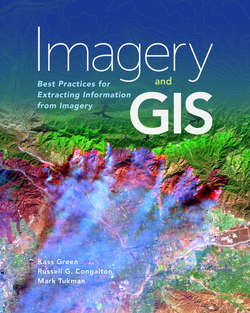Читать книгу Imagery and GIS - Kass Green - Страница 53
На сайте Литреса книга снята с продажи.
Temporal Resolution
ОглавлениеTemporal resolution is determined primarily by the platform and refers to the flexibility regarding the day, time of day, and time between capture of remote sensing images of the same feature by a sensor on the platform.
The highest temporal resolution will always be obtained with a geostationary system. Because weather is constantly changing and must be constantly monitored, many of our weather satellites are geostationary—that is, they rotate above the earth at the same speed as the earth allowing them to remain stationary over a particular region. To remain geostationary, they require an orbit of about 35,786 kilometers above ground, and as a result their spatial resolution is very low. Other examples of high temporal resolution geostationary systems are video cameras placed in banks, at many road intersections, and in high-risk areas such as subway stations and airports. Other applications for fixed platforms include continuous weather observation using a Doppler radar system or continuous spectral monitoring of a specific ground point (e.g., monitoring spectral characteristics of a specific farm crop). However, terrestrial platforms are not practical for most large mapping missions.
Airborne platforms usually offer higher temporal resolution than orbiting space-borne platforms because orbiting platforms are restricted by their orbits, which determine how often and when a spaceborne platform will pass over a specific location on the earth. Conversely, airborne platforms can be flown at any time of day or night but may be restricted from flying over a specific area such as a war zone.
Because passive systems rely on the energy of the sun, they will always have lower temporal resolution than active systems, which can be flown at any time of the day or night. Because satellites are tied to their orbits, they will never have the temporal resolution of aircraft systems in countries where airspace is relatively unrestricted (as opposed to severely restricted airspace over countries such as Iraq or North Korea). Sun-synchronous satellites capture imagery during the same period every day, which reduces their versatility. Aircraft can often fly under clouds, and image collections can be specifically timed to tidal stages, crop calendars, or deciduous leaf conditions.
